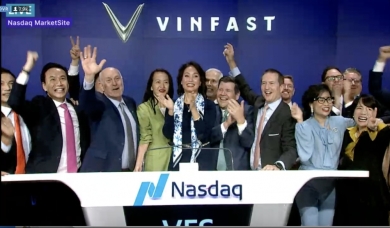Singapore and Malaysia join to weave a path between America and China.

As the great powers battle it out over the shape of the world order, visionary leaders of small nations are pragmatically positioning themselves as best they can for whatever comes next.
Caught between China and America in the contested Indo-Pacific region, the ASEAN nations are crafting an approach in which they do not have to choose between behemoths but can take advantage of the trade wars between them. Within that Southeast Asian association of nations, Singapore and Malaysia are leading the way, putting their rivalrous post-colonial history behind them to focus on the future.
This month the prime ministers of Singapore and Malaysia, Lawrence Wong and Anwar Ibrahim, respectively, agreed to the establishment of a joint “special economic zone” with low corporate taxes for the next 15 years for companies investing in high-end manufacturing or high-tech areas like AI and quantum computing.
The Johor-Singapore Special Economic Zone is modeled on the Shenzhen SEC established decades ago in southern China that has become a global technology hub with a population that has grown larger than Hong Kong. The idea is to provide a “China plus one” space where multinational companies with Chinese factories can hedge their bets against tariffs and trading bans by diversifying their operations to a geopolitically neutral space.
The two leaders seek to leverage the complementary advantages of each country to the benefit of both and the wider ASEAN neighborhood.
Singapore is a densely populated, wealthy financial and logistics entrepot extensively integrated with the world economy, but with no natural resources of its own. GDP per capita among its mere 6 million people in 284 square miles of territory is $94,000. Malaysia’s comparable figure is $14,000 among a population of 34 million.
Malaysia has loads of affordable land, water, energy and labor. In recent years it has developed Penang into a major locale for semiconductor fabrication as well as for expansive data centers that service Nvidia, Microsoft and China’s ByteDance, among others.
The Vision Of Asia’s Nation Builders
In a twist of history, this innovative plan weaves together the long-term visions of two of Asia’s towering nation-builders — Lee Kuan Yew and Mohammed Mahathir — who were perennially at odds when they were neighboring rulers.
Lee, the founding leader of Singapore, died in 2015. The mercurial Mahathir, now 99 years old, was prime minister of Malaysia from 1981 to 2003 and again from 2018 to 2020. Across those terms in office, he was at different moments a mentor to the present prime minister, Anwar Ibrahim, then his persecutor, then again helped foster his path to power.
A Nation With No Hinterland
In several conversations over the years at Istana, the former British governor’s residence, Lee recounted how his nation’s birth pangs shaped its future. During the heyday of post-colonialism in 1963, he sought to safeguard tiny Singapore’s newfound independence from Great Britain by proposing a federation with Malaysia. Though economics, geography and ties of kinship logically dictated such a sensible arrangement, it came undone within two years over ethnic tensions and nationalist intrigue. In 1965, Malaysia cut loose its neighbor.
As a forlorn Lee put it after the split, Singapore had to figure out how to survive as “a heart without a body.” The city-state at the tip of the Malay Peninsula had few resources to prosper on its own. Literally, it had no hinterland.
Lee had the imagination to reconceptualize Singapore as what he called “the first globalized nation.” The Cambridge-trained barrister made the obstacle the way by turning the world at large into the island nation’s extended hinterland.
Within 30 years, he raised Singapore from a third-world to a first-world country through policies of open trade, investment and finance, where global companies could be assured of the rule of law and the absence of corruption. He settled ethnic tensions by ensuring rights and opportunities for all resident Chinese, Indians and Malaysians, including the provision of housing, which cemented the allegiance of citizens to the system. He made English the common language, tying diverse Singaporeans together while connecting them to the world dominated then by Anglo-Saxon powers.
In effect, the present moves toward making the two countries more of a singular economic unit regain the advantages of a territorial hinterland Singapore lost in 1965.
From Rubber Colony To High-Tech Platform
Malaysia’s transition from a one-time rubber colony to a global platform for chip manufacturing and data centers today can be traced to Mahathir’s vision to make it so, long before the likes of Facebook or TikTok even existed, and when Nvidia was in its infancy.
“Because their survival depends on it, leaders of smaller nations can often see the world and where it is headed more clearly than others.”
When I first met Mahathir in 1997, he described that vision, which has now unfolded to encompass the new Singapore-Malaysia collaboration.
To escape the curse of the middle-income trap afflicting so many developing countries, he told me, “We have to take the next step into the information age. And this requires a special approach that is not just about upgrading the old manufacturing industry, but a new collaborative way of doing business through networking and webs of relationships.
We want to create the most conducive environment in the world through our Multimedia Super Corridor for digital commerce — replete with rapid-track permit process, tax-free incentives and protection of intellectual property.”
The Johor-Singapore SEC is essentially a descendant of Mahathir’s corridor.
He continued: “This approach recognizes a fundamental new reality: Where countries once competed with one nation’s trade surplus resulting in another’s trade deficit, in the future both countries can benefit because networks of companies can collaborate across borders to deliver value to customers. … Countries can, for the first time in history, escape the competitive zero-sum logic and enrich each other.”
Even then, he understood the fault lines of globalization, noting that “for a limited time, there will be a relatively level playing field where developing and developed countries can work together to their mutual benefit.” With that prospect in mind, he hastened to exploit the openness of that era to prepare for when the window might close.
Because their survival depends on it, leaders of smaller nations can often see the world and where it is headed more clearly than others. One can only admire the capacity of Asian leaders like Lee and Mahathir to take the long view and see it through, pragmatically, adjusting their vision to changes around them.
In doing so, they laid the foundations for a mutually beneficial path that straddles the divide among greater powers that are being sucked back into damaging zero-sum games. In the present global disorder, leaders elsewhere would do well to learn from them.
Correction: On Jan. 31, 2025, this essay was corrected to reflect that the prime minister of Singapore is Lawrence Wong, not Alex Wang.
By Nathan Gardels - NoemaMag









